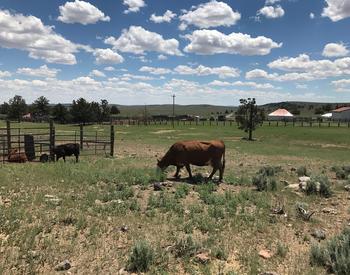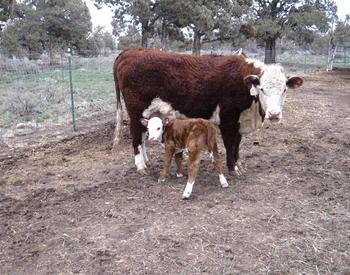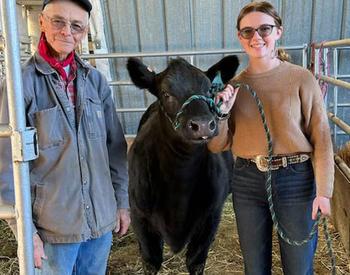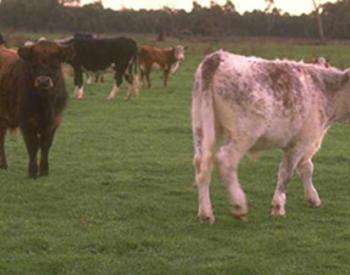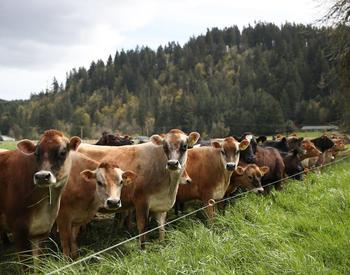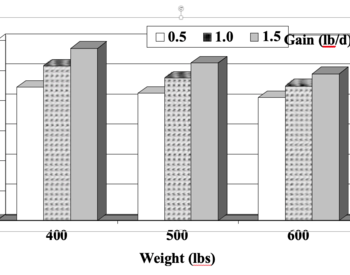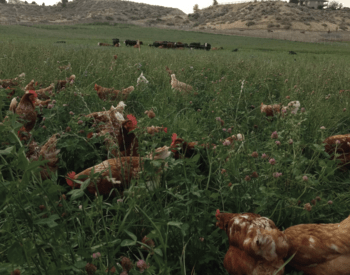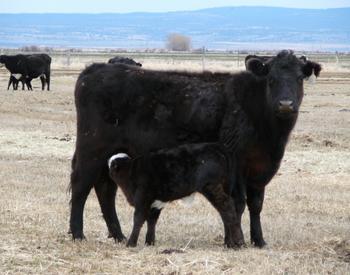Introduction
Energy is the potential to perform work. In cattle, this “work” means the body functions required to keep the animal alive and also functions associated with production, such as growth, lactation and reproduction.
Energy requirements of cattle depend mainly on age, sex, body size, physiological state, and environment. To meet their energy requirements, cattle rely on intake of energetic feeds. In cattle fed diets lacking in energy content, supplementation is often required to optimize animal performance. Therefore, energy nutrition is an important component of nutritional programs in beef cattle operations.
This article will provide some basic concepts regarding energy nutrition, which can be utilized by beef producers to enhance the nutritional management and, consequently, productivity of the herd.
Measures of energy
Feed content and animal requirements for protein or minerals can be quantified in weight scales. In contrast, energy cannot be quantified in absolute values, whereas energy content of feeds or energy requirements of cattle are measured in reference to a known standard.
The most accepted standard for energy measure in cattle nutrition is the calorie, which refers to the amount of energy required to raise the temperature of 1 gram of water 1° Celsius. In relation to the amount of energy required and consumed by cattle daily, a calorie is a small value; therefore, megacalories (Mcal; equal to 1 million calories) is the unit commonly used for cattle nutrition.
Several measures of energy have been developed and are commonly used to evaluate the caloric content of a specific feed, or the amount of calories required for the animal to live (maintenance), grow or lactate (Figure 1). Specific characteristics of these measures are:
- Gross energy (GE) — The amount of energy released as heat when a specific feed is combusted. This is mostly a chemical measure and doesn't distinguish between the animal that will be available, or not, to the animal.
- Digestible energy (DE) — GE of the feed minus the energy lost in feces. It is a better assessment of energy value because the majority if energy lost from a consumed feed is via feces. The energy retained in the body is then classified as "digested" energy. However, DE doesn't account for energy losses associated with urination, digestion process and metabolism.
- Total digestible nutrients (TDN) — A measurement commonly used in cattle nutrition, TDN is very similar to DE, but also accounts for the digestible protein content of the feed because protein also has an energy value. In contrast to other energy measures, TDN can be calculated on a weight basis, where 1 pound of TDN corresponds to 2.0 Mcal of DE.
- Metabolizable energy (ME) — Calculated as DE minus the energy lost in the urine and gasses produced during the digestion process. Therefore, it better estimates the amount of available energy that a specific feed provides to the animal. Typically, ME corresponds to 82% of DE because urine and gas losses are similar among most feeds.
- Net energy (NE) — Corresponds to the ME minus the energy lost as heat during the digestion process. Therefore, it estimates the amount of energy from a specific feed that was retained and absorbed by the animal. For beef cattle nutrition, NE of feeds and NE requirements of cattle can be divided into NE for maintenance (NEm), NE for growth (NEg) and for lactation (NE1).
Currently, beef producers, nutritionists and veterinarians can manage energy nutrition of cattle using simpler measures such as TDN, or more complex calculations such as the NE system. Regardless of which system is used, the most important point to remember is to always provide cattle with adequate amounts of available energy for the expected level of performance.
Importance of energy for cattle production
Energy is required for every single biological reaction in the body. Without adequate energy intake, vital organs do not operate properly, cells do not multiply, bones and muscle tissues do not grow, the mammary gland does not produce milk and reproduction is halted. Therefore, adequate energy nutrition is essential for all the following functions associated with cattle production:
Maintenance
Comprises essential metabolic processes that require energy, such as heart beat, brain activity, respiration and all other vital functions. Physical activity is also classified as maintenance. Maintenance requirements for energy are defined as the amount of energy intake that will result in no loss or gain of body weight. Typically, the ME required for maintenance represents 70% of the total ME requirement of mature cows, 90% of the ME requirement of mature bulls, and at least 50% of the ME requirement of growing cattle.
Growth
Cattle growth depends on the multiplication and enlargement of cells within bone, muscle, fat and organ tissues. Energy is directly required to fuel every single cell function, including multiplication. Energy is also required for the synthesis of hormones that stimulate cell and tissue growth.
Health
The immune system, as well as any other body process, requires energy to work properly. Animals that do not consume enough energy are highly susceptible to diseases. Energy is required for synthesis and function of cells and substances associated with cattle health, including antibody production. Energy status also helps determine the success of vaccinations programs; cattle should be in adequate energy status for optimal vaccine response.
Lactation
The cells within the mammary gland require significant amounts of energy to produce milk. Energy is also fundamental for the synthesis of milk fat, protein and lactose. However, a cow can mobilize energy reserves to support milk production if energy intake is deficient, although excessive mobilization of reserves is detrimental to reproduction and health.
Reproduction
Energy is the primary nutritional consideration for optimal reproductive performance of cattle. Energy modulates the synthesis of hormones that control reproduction, such as GnRH, LH, and progesterone. In addition, energy modulates the communication between the fetus and the dam during the initial phases of gestation so the pregnancy can be established and maintained.
Gestation
Throughout gestation, particularly during the last trimester, the energy requirements of cows increase significantly because of development of the placenta and fetal growth. During this period, the cow has to consume enough energy to meet her own maintenance requirements and also to support the development of the pregnancy (fetus, uterine membranes and fluids). The demand for energy further increases immediately prior to calving because of milk/colostrum production. Even if a gestating cow does not consume enough energy, she is still able to provide adequate amounts of energy to the placenta/fetus by mobilizing her own energy reserves. However, a cow mobilizing substantial amounts of energy reserves during late gestation may experience calving complications, greater postpartum interval and health problems.
In beef cattle, energy is typically used in a specific hierarchical order (Figure 2) to preserve the critical functions of the animal and prevent unnecessary use of energy when intake is inadequate. The main priority of consumed energy is to supply the requirements for vital body functions, which include maintenance, health and replacement of lost tissues.
In growing animals, such as replacement heifers and young bulls, the requirement for growth can also be classified as a vital body function. If the requirements for body functions are met, the remaining energy is directed first to lactation and then to reproduction in females, whereas in males it goes directly to reproduction.
Any remaining energy is then stored as reserve, mainly as fat tissues, so the animal can mobilize and utilize it to support body functions, such as lactation and reproduction, if energy intake becomes inadequate. If energy intake is insufficient to meet all requirements for a significant amount of time, energy reserves are mobilized and may become depleted.
Without proper energy availability, reproduction is the first trait that becomes impaired. The beef cow prioritizes herself and her ability to nurture a current offspring by preventing additional energy expenditure with a new pregnancy. This event is more predominant in cows than bulls because the energy requirements for generating and maintaining a pregnancy are much greater compared with sperm production.
If energy availability becomes further reduced, females shut down lactation. In cases where energy intake cannot meet the requirements for vital body functions, the animal begins to breakdown its own muscle tissues to generate energy, whereas any physical activity is reduced and the immune system becomes impaired. Finally, energy starvation for prolonged periods can lead to death.
Feeding energy to cattle
The beef industry in Oregon relies on low-quality forages as an important feed source for cattle. These forages do not always have adequate energy content to meet the requirements of some cattle categories, such as developing heifers and lactating brood cows, even when protein supplements are provided. Consequently, supplemental energy is required.
Energy feeds can also be used as a forage substitute when forage availability is inadequate. Generally, 1 pound of an energy-dense feed, such as corn, can replace 1.5 to 2 pounds of forage. However, this practice is often expensive because forage is normally the cheapest source of nutrition for cattle.
The most common energy feeds available to cattle are based on high-starch grains (corn, sorghum, barley, wheat), fibrous byproducts (soybean hulls, wheat middlings and beet pulp), or fat sources (oilseeds, animal and vegetable oils).
Contrary to protein supplements, energy supplements often decrease forage intake because of decreased ruminal fiber digestibility. Typically, forage intake is decreased when grains are supplemented above 0.5% of body weight and fat sources exceed 3% of the diet dry matter.
Conversely, fibrous byproducts can be supplemented to cattle up to 0.8% of body weight without impairing forage intake and digestibility, resulting in similar performance compared to the other energy sources. However, producers should consider many factors when supplementing byproduct feedstuffs to cattle, such as availability, shipping, variation in nutrient content, and any additional labor/equipment to store and feed byproducts.
Supplementing cattle infrequently, such as once or three times weekly instead of daily, is a common strategy to decrease costs of production because the expenses associated with labor, fuel and equipment are reduced. This strategy can be successful when protein supplements are fed to cattle; supplementing cattle as infrequently as once a week instead of daily does not alter performance.
However, decreasing the supplementation frequency of energy supplements to cattle has been shown to be detrimental to animal production. Reducing supplementation frequency of grain-based feeds impairs forage digestibility and intake because cattle receive bolus amounts of grains instead of smaller portions when supplemented.
Conversely, infrequent supplementation with fibrous byproducts does not alter forage intake and digestibility, but reduces the efficiency of nutrient utilization and, consequently, cattle performance. Therefore, energy supplements should be offered daily to optimize feed efficiency and production traits in cattle.
Conclusions
Energy is required for every single body function, particularly those associated with animal production. Without proper energy nutrition, cattle health, growth, reproduction and lactation are seriously impaired. Many forages do not provide enough energy to cattle, particularly to high-demanding animals such as replacement heifers and lactating cows. Therefore, well-planned energy supplementation programs are essential to maintain cattle at adequate levels of nutrition and performance.
References
Bohnert, D., and T. DelCurto. In: Cow-Calf Management Guide, CL317.
Bowman, J.G.P. and D. W. Sanson. 2000. In: T. DelCurto (Ed.) Strategic supplementation of beef cattle consuming low-quality roughages in the western United States. Oregon Agric. Exp. Station Special Report, Oregon State University Printing, Corvallis.
Hess et al., 2008. J. Anim. Sci. 86:E188-E204.
NRC. 1996. Nutrient Requirements of Beef Cattle. National Academy Press, Washington, D.C.
This document is part of the Oregon State University Beef Cattle Library. Prior to acceptance, this document was anonymously reviewed by two experts in the area.
